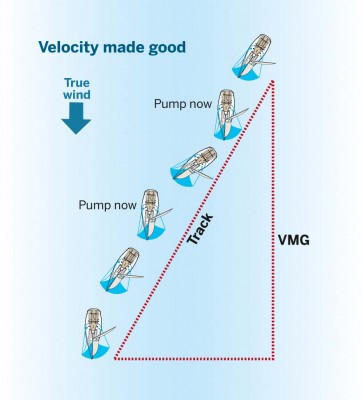Using waves to increase downwind speed is a dinghy skill useful in big boats too. Jonty Sherwill asks dinghy sailor and Volvo Ocean Race winner Rob Greenhalgh for his tips
Gone are the days of sitting back on the downwind legs to enjoy the view. Powerful modern cruiser-racers respond much more like dinghies and need the constant application of subtle steering input, as well as well-timed pumping of the sails, to keep the boat on each wave longer for good downwind performance.
IRC is honed to level the playing field as much as possible between heavy and light displacement yachts, but the lighter boats that plane more easily still need to maximise their gains on breezy runs by using good technique if they are to stand a chance of holding off the heavy brigade on the upwind legs.
The benefit of getting your surfing technique right is best gauged when there’s a comparable boat nearby. But knowing what to do, how much and when can be difficult to judge. The reward can be a significant increase in VMG towards the bottom mark, but it’s also important to understand what the rules allow to avoid being protested.
1. Pick the right route
There may be better surfing waves on one side of the course so investigate pre-start; don’t leave it until the first downwind leg to find out. The best surfing conditions can exist soon after large windshifts so think about that after a large shift on a beat – there could be some good surfing to be found on the next downwind leg. Offshore wavetrains are important – set up your downwind leg strategy to use the wavetrain/direction to the maximum.
2. Velocity made good (VMG)
Don’t be afraid to be ‘off-angle’ when using the waves. Sometimes the wave direction can exist either above or below the boat’s optimum VMG angle, but if the waves are promoting surfing then use them. This will vary from boat to boat and will depend on how high you have to go to get the boat surfing, but if the wave angle is lower than VMG then that’s a bonus.
3. Riding the waves
Keep looking for the next wave. Once you are on a wave, don’t just go ploughing to the bottom of the wave and slam into the back of the one in front. Instead, as you come down the face of a wave, head the boat up gently, find an escape from the trough and look for the next wave to use. Again the technique will vary from boat to boat.
4. Further, but faster
Knowing your boat is paramount. If the wavetrain is above VMG, then you have to make sure that the extra speed of using the waves will offset the extra distance travelled. Commit to the mode change, work the waves hard and if it means sailing higher, then there will be an initial loss until you start seeing the benefits from using the waves. However, every missed wave is costly.
5. Teamwork
The whole crew will need to change mode, pumping with every wave (once per wave to promote planing is allowed – but no pumping is permitted once the boat is planing or surfing). A simultaneous pump on the main and spinnaker is considered one pump. Coinciding the mode change with a windshift or pressure change can work well, but be quick to change back if it isn’t working or conditions change.
Rob Greenhalgh won the first of his three Volvo Ocean Race campaigns in 2005/6 aboard ABN AMRO One, but made his name in dinghies, including world championships in the International 14 and 18ft Skiff classes. A full-time offshore professional sailor, Greenhalgh still says his first love is dinghy sailing, which includes a new challenge, the foiling International Moth.
This is an extract from a feature in Yachting World November 2014 issue






